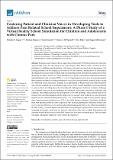| dc.contributor.author | Logan, Deirdre E. | |
| dc.contributor.author | Khanna, Karina | |
| dc.contributor.author | Randall, Edin | |
| dc.contributor.author | O’Donnell, Shealyn | |
| dc.contributor.author | Reks, Talis | |
| dc.contributor.author | McLennan, Logan | |
| dc.date.accessioned | 2023-10-27T18:38:08Z | |
| dc.date.available | 2023-10-27T18:38:08Z | |
| dc.date.issued | 2023-10-01 | |
| dc.identifier.uri | https://hdl.handle.net/1721.1/152531 | |
| dc.description.abstract | Building on growing evidence supporting virtual reality (VR) interventions for pain management, this study describes the process of developing vReal-School (vRS), a VR-based school simulation for children and adolescents with chronic pain and associated school impairment. Following guidelines for developing user-centered VR interventions, initial phases of intervention development focus on understanding and incorporating patient and clinician perspectives when designing this digital health tool. Phase I entailed focus groups with patients undergoing intensive interdisciplinary pain treatment (IIPT). A total of 19 participants across four focus groups shared their experiences related to dealing with pain at school and provided initial feedback on the concept of a VR-based school simulation. In phase II, we pilot-tested a vRS prototype and collected patient and clinician feedback via mixed method approaches. Phase I results highlight four themes related to pain in school, including physical/environmental challenges and solutions, academic challenges and solutions, peer interaction challenges and solutions, and teacher interaction challenges and solutions. These themes guided the development of our vRS prototype. Nine patients and eleven treating clinicians then engaged with the vRS prototype and provided feedback via semi-structured interviews and validated self-report measures. The results indicate high levels of patient engagement/immersion (mean total score of 17.0 on the Child Presence Measure). Qualitative feedback from both groups identified positive aspects of vRS, including finding the simulation realistic and easy to use and offering ways to address school functioning goals that are not otherwise feasible in the IIPT setting. Areas for improvement included integrating more physical movement as well as increasing the number of scenarios and the level of demands of the tasks available. Both patients and clinicians found vRS to be useful in the IIPT context and relevant to treatment goals. This user input will guide subsequent iterations of intervention development. | en_US |
| dc.publisher | Multidisciplinary Digital Publishing Institute | en_US |
| dc.relation.isversionof | http://dx.doi.org/10.3390/children10101644 | en_US |
| dc.rights | Creative Commons Attribution | en_US |
| dc.rights.uri | https://creativecommons.org/licenses/by/4.0/ | en_US |
| dc.source | Multidisciplinary Digital Publishing Institute | en_US |
| dc.title | Centering Patient and Clinician Voices in Developing Tools to Address Pain Related School Impairment: A Phase I Study of a Virtual Reality School Simulation for Children and Adolescents with Chronic Pain | en_US |
| dc.type | Article | en_US |
| dc.identifier.citation | Children 10 (10): 1644 (2023) | en_US |
| dc.contributor.department | MIT.nano | |
| dc.identifier.mitlicense | PUBLISHER_CC | |
| dc.eprint.version | Final published version | en_US |
| dc.type.uri | http://purl.org/eprint/type/JournalArticle | en_US |
| eprint.status | http://purl.org/eprint/status/PeerReviewed | en_US |
| dc.date.updated | 2023-10-27T10:26:50Z | |
| dspace.date.submission | 2023-10-27T10:26:50Z | |
| mit.license | PUBLISHER_CC | |
| mit.metadata.status | Authority Work and Publication Information Needed | en_US |
